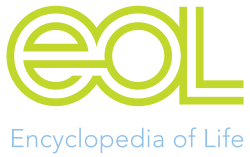Encyclopedia of Life
|
|
|
|---|---|
| online encyclopedia | |
| languages | 18 different languages |
| Registration | optional |
| On-line | 2008 (currently online) |
| https://eol.org/ | |
The Encyclopedia of Life ( EOL for short , German Encyclopedia of Life ) is an online encyclopedia that will contain entries prepared by experts on all known types of living beings . It will be freely accessible. Many entries will contain video and audio files, images, graphics, and text.
Currently (as of June 2020) the encyclopedia lists almost 2 million species in approx. 190,000 genera and over 13,000 families .
history
The Encyclopedia of Life was opened in February 2008 and already had over 30,000 different pages in its repertoire. The basic idea of this encyclopedia is to collect information about all animal, mushroom and plant species known to us and to make it publicly available. Articles on microorganisms and non-cellular systems such as viruses will follow later . The authors expected to have over 1.77 million articles available a decade later. The articles serve both the public and, above all, science in recording the entire earth ecosystem, as well as researching ecological problems.
However, the rush to the site was completely underestimated, which is why it collapsed under the onslaught of visitors, after which it was switched to a demonstration mode, in the German version only six different pages could be seen. According to the operators, the website was accessed over 11.5 million times within the first 5 hours. The difference between Wikipedia and the Encyclopedia of Life is the authors. While Wikipedia is largely written by volunteer authors, the Encyclopedia of Life can also be written by anyone, although contributions are reviewed by scholars. A budget of around 100 million US dollars is currently available for building the encyclopedia .
A year later, the encyclopedia consisted of over 170,000 articles. According to Managing Director James Edwards, this would mean that although the schedule was to record over 1.8 million known species within a decade, there was a steady growth rate of new contributions.
In September 2011 the second version of the Encyclopedia of Life (EoLv2) was published. This version brought a new design, and the website no longer only consisted of 30,000 pages, but now consisted of over 700,000 different pages.
On January 10, 2014, the Encyclopedia of Life launched TraitBank , a searchable, repository of organism traits , measurements, interactions, and other facts for all taxa. TraitBank is integrated into the Encyclopedia of Life and uses the existing infrastructure for names, content organization and search. Data sets are aggregated from databases, literature tables and other sources.
The Encyclopedia of Life has been working with IBM since October 2016 . They want to answer scientific questions using IBM's Watson supercomputer . One of the questions they want to answer is the plankton paradox , according to EoL Director Bob Corrigan.
The third version of the Encyclopedia of Life is now available. During the development of this version, the focus was primarily on the development of a new, mobile phone-friendly layout, since - according to the developers - many visitors would visit the website via a mobile device. In addition, the platform was completely rewritten and brought up to modern standards.
Participation
Five major institutions are currently involved in the project, with more to follow: Harvard University , Smithsonian Institution , Field Museum in Chicago , Missouri Botanical Garden , Biodiversity Heritage Library , Marine Biological Laboratory Woods Hole , Massachusetts . They are all coordinated by a board chaired by James Hanken , director of the Louis Agassiz Museum of Comparative Zoology at Harvard University.
software
The software for the project is currently being developed by young biologists and computer scientists at the Marine Biological Laboratory in Woods Hole, 130 km from Boston, under the direction of taxonomist David J. Patterson . The principle of obtaining information is implemented through interfaces to large databases, including Catalog of Life , FishBase , AmphibiaWeb .
Copyright protection
Very permissive to restrictive Creative Commons licenses are used.
literature
- Samiha Shafy: Inventory of Life . In: Der Spiegel . No. 19 , 2008, p. 156 f . ( online ).
Web links
- Website of the Encyclopedia of Life (English)
- Online lexicon should cover all life . Spiegel Online , May 9, 2007
- Trait bank
Individual evidence
- ↑ Living Things. Encyclopedia of Life, accessed June 13, 2020 .
- ^ The Encyclopedia of Life, No Bookshelf Required. February 26, 2008, accessed May 21, 2019 .
- ↑ A huge rush paralyzes the encyclopedia of life. February 27, 2008, accessed May 21, 2019 .
- ↑ a b c Lexicon of Life already has 170,000 entries. August 24, 2009. Retrieved May 21, 2019 .
- ↑ Explore the relaunched Encyclopedia of Life: EOLv2. September 6, 2011, accessed May 21, 2019 .
- ↑ TraitBank: Practical semantics for organism attribute data. (PDF) 2014, accessed on May 21, 2019 (English).
- ↑ Data Now Available from the Encyclopedia of Life (eol.org). May 8, 2014, accessed May 21, 2019 .
- ↑ Big Data Just Got Bigger as IBM's Watson Meets the Encyclopedia of Life. October 18, 2016, accessed May 21, 2019 .
- ↑ What's New? Retrieved May 21, 2019 .
- ^ Catalog of Life
- ↑ Amphibia Web
- ↑ Creative Commons licenses from the Encyclopedia of Life (English)
